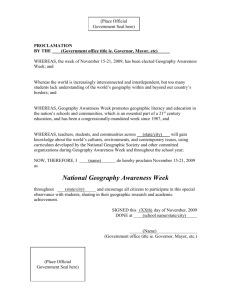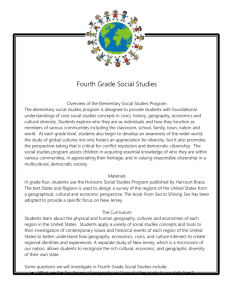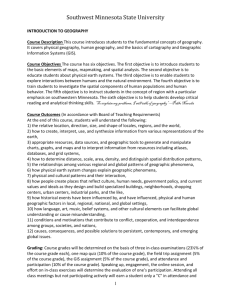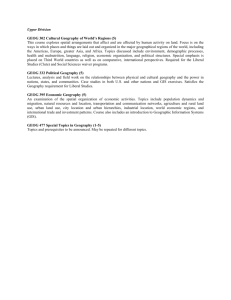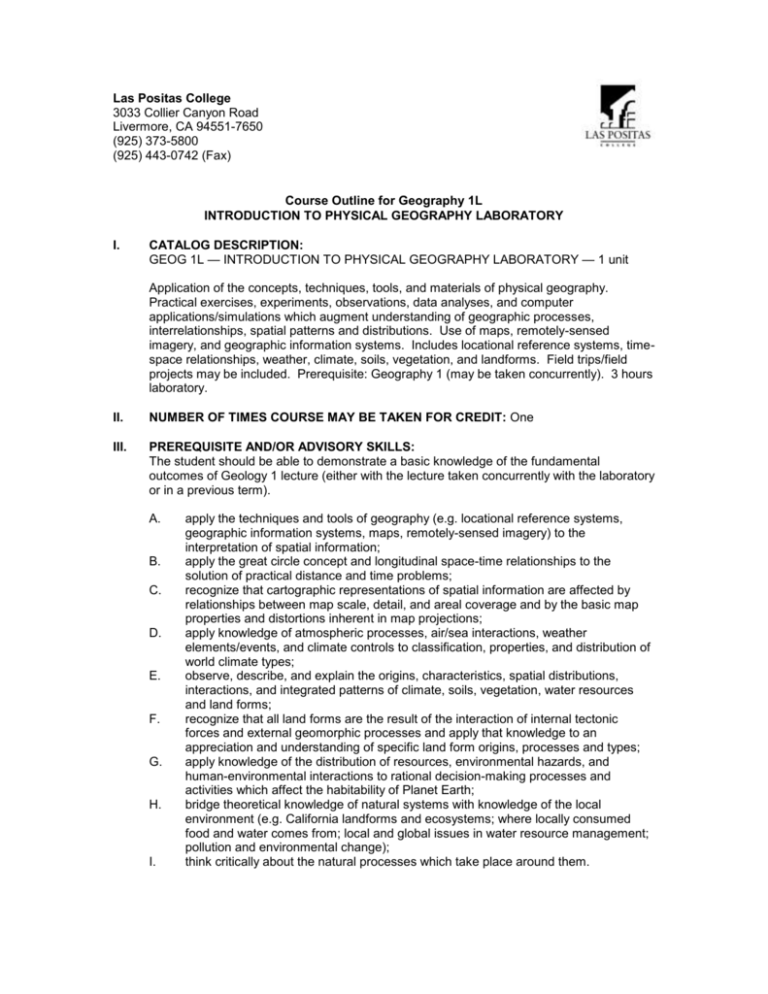
Las Positas College
3033 Collier Canyon Road
Livermore, CA 94551-7650
(925) 373-5800
(925) 443-0742 (Fax)
Course Outline for Geography 1L
INTRODUCTION TO PHYSICAL GEOGRAPHY LABORATORY
I.
CATALOG DESCRIPTION:
GEOG 1L — INTRODUCTION TO PHYSICAL GEOGRAPHY LABORATORY — 1 unit
Application of the concepts, techniques, tools, and materials of physical geography.
Practical exercises, experiments, observations, data analyses, and computer
applications/simulations which augment understanding of geographic processes,
interrelationships, spatial patterns and distributions. Use of maps, remotely-sensed
imagery, and geographic information systems. Includes locational reference systems, timespace relationships, weather, climate, soils, vegetation, and landforms. Field trips/field
projects may be included. Prerequisite: Geography 1 (may be taken concurrently). 3 hours
laboratory.
II.
NUMBER OF TIMES COURSE MAY BE TAKEN FOR CREDIT: One
III.
PREREQUISITE AND/OR ADVISORY SKILLS:
The student should be able to demonstrate a basic knowledge of the fundamental
outcomes of Geology 1 lecture (either with the lecture taken concurrently with the laboratory
or in a previous term).
A.
B.
C.
D.
E.
F.
G.
H.
I.
apply the techniques and tools of geography (e.g. locational reference systems,
geographic information systems, maps, remotely-sensed imagery) to the
interpretation of spatial information;
apply the great circle concept and longitudinal space-time relationships to the
solution of practical distance and time problems;
recognize that cartographic representations of spatial information are affected by
relationships between map scale, detail, and areal coverage and by the basic map
properties and distortions inherent in map projections;
apply knowledge of atmospheric processes, air/sea interactions, weather
elements/events, and climate controls to classification, properties, and distribution of
world climate types;
observe, describe, and explain the origins, characteristics, spatial distributions,
interactions, and integrated patterns of climate, soils, vegetation, water resources
and land forms;
recognize that all land forms are the result of the interaction of internal tectonic
forces and external geomorphic processes and apply that knowledge to an
appreciation and understanding of specific land form origins, processes and types;
apply knowledge of the distribution of resources, environmental hazards, and
human-environmental interactions to rational decision-making processes and
activities which affect the habitability of Planet Earth;
bridge theoretical knowledge of natural systems with knowledge of the local
environment (e.g. California landforms and ecosystems; where locally consumed
food and water comes from; local and global issues in water resource management;
pollution and environmental change);
think critically about the natural processes which take place around them.
Course Outline for Geography 1L
Page 2
INTRODUCTION TO PHYSICAL GEOGRAPHY LABORATORY
IV.
EXPECTED OUTCOMES FOR STUDENTS:
Upon completion of this course, the student should be able to:
A.
B.
C.
D.
E.
F.
V.
apply the techniques, tools, and concepts of geography to the interpretation and
analysis of spatial information, with emphasis on:
1.
the geographic grid and locational concepts,
2.
space-time relationships,
3.
maps,
4.
geographic information systems and remote sensing technologies.
apply knowledge of atmospheric processes, air/sea interactions, weather
elements/events, and climate controls to the classification, properties, and
distribution of world climate types.
observe, describe, and explain the origins, characteristics, spatial distributions,
interactions, and integrated patterns of climate, soils, vegetation, water resources,
and land forms.
recognize that all land forms are the result of the interaction of internal tectonic
forces and external geomorphic processes.
apply knowledge of these external and internal processes to an appreciation and
understanding of the origins, characteristics, and spatial distributions of specific land
forms.
apply knowledge of resources, environmental hazards, and human-environmental
interactions to rational decision-making processes and activities which affect the
habitability of Planet Earth.
CONTENT:
A.
Distance Concepts
1.
Length of a Degree on a Great Circle
2.
Proportional Relationship of a Globe to the Earth
3.
Verbal, Representative Fraction, Graphic Scales
B.
Locational Reference Systems
1.
Geographic Grid and Coordinates
2.
Metes and Bounds
3.
Land Ordinance of 1785 (Township and Range)
4.
French Long Lot
5.
Land Grants
C.
Longitude and Time Relationships
D.
Maps
1.
Marginal Information, Systems, Legends
2.
Relief Representation
3.
Scale, Area, Detail Relationships
4.
Measurements of Distance and Direction
5.
Slope Measurements, Profiles
6.
Projections and Their Properties
7.
Thematic and Topographic Map Interpretation
E.
Remotely-Sensed Imagery (Satellite, Photographic)
1.
Platforms and Sensors
2.
Physical and Cultural Signatures
F.
Geographic Information System Applications (at instructor’s discretion)
1.
Exploring Tropical Cyclones
a.
Recipe for a Cyclone
b.
The Live of a Cyclone
c.
Hurricane Hazards
d.
Hurricanes in the Big Apple
2.
Exploring the Dynamic Earth
3.
Exploring Water Resources
a.
Global Water Resources
Course Outline for Geography 1L
Page 3
INTRODUCTION TO PHYSICAL GEOGRAPHY LABORATORY
G.
H.
I.
J.
K.
L.
M.
VI.
b.
The Renewable Resource
c.
US Water Use
d.
A Thirsty Town in the Desert
Earth-Sun and Seasonal Relationships
1.
Determination of Sun’s Declination, Altitude Angle
2.
Determination of Duration of Daylight
3.
Temporal and Spatial Distribution of Insolation
Multiple Applications in Weather Topics
1.
Temperature Measures, Distribution, Cycles
2.
Atmospheric Pressure/Winds and Oceanic Circulation
3.
Atmospheric Moisture and Stability
4.
Precipitation Processes/Distribution and Water Budgets
5.
Frontal Analysis and Identification of Associated Weather Characteristics on
Synoptic Charts
Climate Applications
1.
Climate Controls
2.
Climate Classification and the use of Climographs
3.
Computer Simulations/Modeling of Climate Change
Soils Applications
1.
Soil Properties
2.
Classification
3.
Soil Survey Map Interpretation
Vegetation Applications
1.
Plant Identification and Adaptations
2.
Classification
3.
Climate, Soils, Vegetation Associations
Earth Materials
1.
Mineral and Rock Classification and Identification
2.
Landscape Expression
Landform Map/Image Analysis/Interpretation, Exercises, Simulations
1.
Types
2.
Processes
3.
Spatial Distribution and Environments
4.
Land Use and Modification
5.
Drainage Patterns
METHODS OF INSTRUCTION:
A.
Laboratory Sessions
1.
Short Introductory Lectures
a.
Chalkboard/Whiteboard Presentation
b.
Overhead Transparencies
c.
Web Sites
2.
Individual and Group Work
a.
Laboratory Manual
b.
Topographic Maps
c.
GIS Investigations Workbook
B.
Field Trip (optional)
1.
Oakland Museum
C.
Group Presentations (optional)
D.
CD-ROM
1.
ArcView® GIS software
a.
Exploring Tropical Cyclones
b.
Exploring the Dynamic Earth
c.
Exploring Water Resources
2.
TASA Graphic Arts, Inc. Introduction to Topographic Maps
E.
Web-Based Resources
Page 4
Course Outline for Geography 1L
INTRODUCTION TO PHYSICAL GEOGRAPHY LABORATORY
1.
2.
3.
USGS Geography home page: http://geography.usgs.gov/
About.com – Daylight Saving Time:
http://geography.about.com/cs/daylightsavings/a/dst.htm
About.com – Equator, Hemispheres, Tropic of Cancer and Tropic of
Capricorn: http://geography.about.com/library/misc/blequator.htm
VII.
TYPICAL ASSIGNMENTS:
A.
Laboratory Manual
1.
Complete Exercise A: Geographic Grid, Shape and Size of the Earth, except
for section A-3. Turn in the completed worksheets at the end of the laboratory
period.
B.
Topographic Maps
C.
GIS Investigations Workbook
1.
Complete Unit 1 in the Exploring Tropical Cyclones book: Recipe for a
Cyclone. Be sure to answer all the questions, and follow along with the
appropriate ArcView GIS application as directed. Present your workbook for
instructor check-off at the end of the lab period.
VIII.
EVALUATION:
A.
Methods
1.
Laboratory exercises and assignments
2.
Quizzes/Exams at instructor’s discretion
3.
Final Exam or Final Project
B.
Frequency
1.
Weekly laboratory exercises and assignments
2.
Recommend bi- or tri-weekly quizzes and final exam (or) two or three midterm
(unit) exams and final exam
3.
Student projects to be assigned at the discretion of the instructor
C.
Typical Problems
1.
Laboratory Exercises
a.
Laboratory Manual
i.
Parallels and Meridians (a) Sketch in and label the following
parallels of latitude: (1) 35oN (2) 10oS (3) Tropic of Cancer (4)
Tropic of Capricorn (5) Arctic Circle (6) Antarctic Circle (Visible
from this angle?)
Image from: http://geography.sierra.cc.ca.us/booth/cultural/chp1_intro/intro2.htm
(b) Sketch in an label the following meridians of longitude: (1)
10oW (2) 20oE (3) 58oW (4) 143oW (5) 0o (Prime
Meridian) (6) 180o (International Date Line)
Image from:
http://geography.sierra.cc.ca.us/booth/c
ultural/chp1_intro/intro2.htm
Course Outline for Geography 1L
Page 5
INTRODUCTION TO PHYSICAL GEOGRAPHY LABORATORY
b.
c.
Topographic Maps
i.
Reference (name of quadrangle):_______
ii.
Quadrangles are also identified by the geographic grid
coordinates of the lower right-hand corner:___________
iii.
Is it a 15’, or a 7 ½’ quadrangle?
iv.
Date of map: _______ Revision date(s)(?): _______
v.
The scale of the map is one of the first characteristics that you
want to note. Identify at least three ways in which the scale of
the quadrangle is presented in the legend.
vi.
Contour interval: _______
vii.
Grid systems other than the geographic grid are usually present,
and are described in the legend. Identify at least two other grid
systems on the map.
viii. What quadrangle joins this one on the south? (Eight adjoining
quadrangles are identified.)
ix.
What information is represented by these colors on the
quadrangle? Blue: _______ Green: _______ Red: _______
Pink: _______ Brown: _______ Black: _______ Purple: _____
x.
Other types of information that are generally available in the map
legend are: Organization(s) that produced the map: _______
Ordering information: _____ Dates of aerial photography: _____
Map projection: _______ Magnetic declination: _______
GIS Investigations Workbook
i.
Exploring Tropical Cyclones Activity 1.2: Discovering cyclone
patterns. Launch the ArcView GIS application, then locate and
open the cyclones.apr project file. Open the Global Patterns
view. Click the Media Viewer button and choose the Hurricane
Andrew Movie fro the list. After the QuickTime Player
application loads the file, play the button to view the movie. (a) In
what direction do Andrew and Lester spin – clockwise or
counterclockwise? (b) What happens to both storms when they
cross over land?
ii.
Now, look at the distribution of hurricanes on the map. Using the
latitude lines on the map, estimate the northern and southern
boundaries of the region where tropical cyclones form. (c) Most
tropical cyclones form between about _____oN latitude and
_____oS latitude.
iii.
Look closely at the area near the equator. There appears to be a
narrow “cyclone-free zone” centered on the equator. Using the
Zoom In tool, zoom in on this cyclone-free zone, and use the Pan
tool to drag the map along the equator. Move your cursor along
the boundaries of the zone and note the latitude in the coordinate
display at the right end of the tool bar. Use the Measure tool to
measure the distance from the equator to the edge of the
cyclone-free zone, as shown at the left. The distance (length) is
given in the status bar. (d) The cyclone-free zone extends
approximately _____ degrees or _____ kilometers from the
equator.
iv.
Click the Zoom to Full Extent button to display the entire map
again. (e) Symmetrical patterns are very common in nature. In
what areas of the world oceans, besides those very near the
equator and the poles, would symmetry lead you to expect
tropical cyclones to form, yet they don’t? Identify these areas on
the map below. (Students see a Mercator-Projection map of the
Page 6
Course Outline for Geography 1L
INTRODUCTION TO PHYSICAL GEOGRAPHY LABORATORY
2.
world) (f) Explain why you expect tropical cyclones to form in
these areas.
Quizzes/Exams
a.
Calculate the oblateness of the Earth. (a) Print the formula and
substitute equatorial and polar diameters in their appropriate positions
in the formula. (b) Answer obtained from your calculator to four decimal
places.
b.
A 40-inch circumference globe has a scale of 1 inch = 625 miles. The
great circle distance between points A and B on the globe is 8 inches.
Calculate the shortest distance, in miles, between points A and B on
earth, using concepts (a), (b), and (c) specified below. Before you
begin, draw a picture on the back of the first page with all of the
appropriate information and relationships that will help you solve this
problem by applying the three concepts. (a) Concept: length of 1o on a
great circle equals approximately 69 miles. Show all appropriate “math”
setups and the intermediate and final results obtained from your
calculator. Intermediate answer (angle) to two decimal places: _____
Final answer to nearest mile (no decimal places): _____ (b) Concept:
circumference of globe (inches) represents circumference of earth
(miles). Show “math” setup and final result obtained from your
calculator. Final answer to nearest mile (no decimal places): ______
(c) Scale concept (again, show “math” setup). Final answer to nearest
mile: _______
IX.
TYPICAL TEXTS:
A.
Corbet, John H. Physical Geography Manual. 5th Edition. Dubuque, IA: Kendall/Hunt,
2003.
B.
Allen, John L. Student Atlas of World Geography. 5rd Edition. McGraw-Hill, 2005.
C.
Hall-Wallace, Michelle, et.al. GIS Investigations for the Earth Sciences package (with
CDs). 1st Edition. Ontario, Canada: Thompson – Brooks/Cole, 2003.
D.
Christopherson, Robert W. Applied Physical Geography: Geosystems in the
Laboratory. 5th Edition. Pearson/Prentice-Hall, 2003.
E.
Computer and Internet access
X.
OTHER MATERIALS REQUIRED OF STUDENTS:
Scientific calculator, protractor, straight edge, sharp lead pencils, colored pencils, ruler,
USGS topographic quadrangles (Livermore, Altamont, home/place of interest), campus
print card.
Creation Date:
10/93
Revision Date:
11/04
Date Approved by Curriculum Committee:
Effective Date:
Fall 2005
12/08/04





